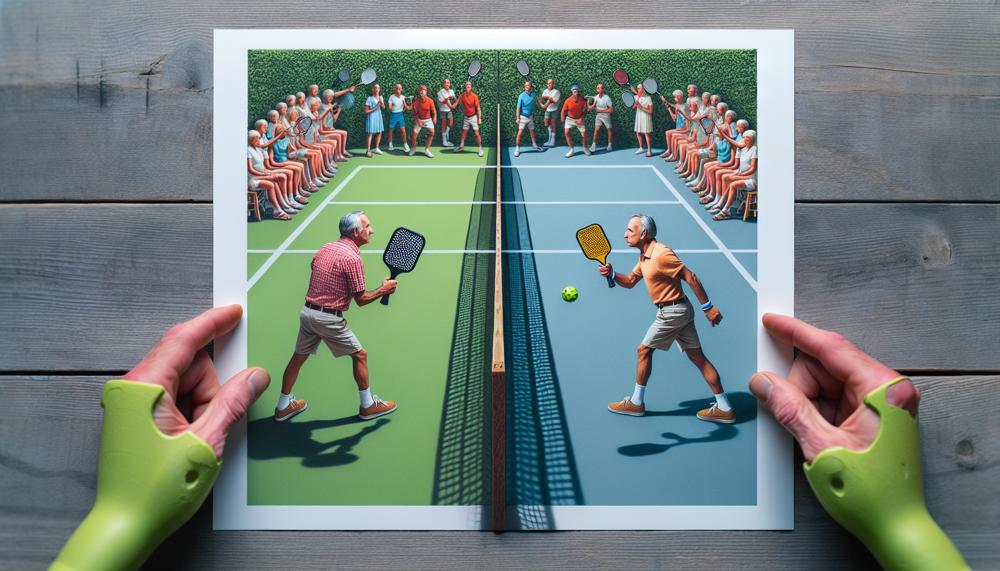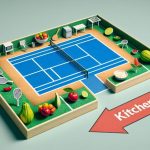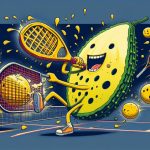Pickleball, the sport that has taken the world by storm, is a unique blend of tennis, badminton, and ping-pong.
It’s no surprise that this relatively new game has gained a massive following in recent years, surpassing even tennis as the fastest-growing sport in America. But what makes pickleball so special?
Is it the quirky name? The smaller court size?
Or perhaps it is for all ages and abilities? In this blog post, we’ll delve into the reasons behind pickleball’s skyrocketing popularity and why it has become a beloved pastime for both young and old players.
Whether you’re an avid athlete or simply looking for a fun new activity, pickleball might just be your next obsession.
Table of Contents
- 1 History and Origins Of Pickleball
- 2 Pickleball vs. Tennis: What’s the difference in equipment?
- 3 Pickleball vs Tennis: Court Dimensions and Layout
- 4 Scoring System: How weird can tennis make it?
- 5 Pickleball Rules vs. Tennis Rules
- 6 Health Benefits of Pickleball and Tennis
- 7 Popularity: Why is pickleball one of the fastest-growing sports?
- 8 Pickleball vs. Tennis: How can I transition from playing tennis to pickleball?
- 9 Pickleball vs. Tennis: Which sport should I play?
- 10 Conclusion
History and Origins Of Pickleball
For racket sports enthusiasts, pickleball has become a well-known name in recent years. This relatively new sport has gained widespread popularity for its unique combination of elements from badminton, tennis, and table tennis.
It offers an enjoyable and challenging game for players of all ages and abilities. But how did this sport come into existence? Let’s delve into the history and evolution of pickleball.
In 1965, three friends on Bainbridge Island, Washington, faced a dilemma: they wanted to play badminton but couldn’t find a shuttlecock. They improvised by using a wiffle ball instead and lowering the badminton net. With ping-pong paddles in hand, they began playing what would become known as pickleball.
The game quickly caught on among their families and friends, leading to the construction of a dedicated court by Bob O’Brian in 1966. Just a year later, Pritchard and his friends founded Pickle-Ball Inc., which was later renamed Pickle-Ball Inc.
The 1970s marked the first pickleball tournament in Tukwila, Washington. Through community centers and schools, the sport’s popularity continued to grow throughout the late 1970s and 1980s. By the 1990s, pickleball had taken hold nationwide.
People of all ages now play pickleball, which is a global sport. According to the Sports and Fitness Industry Association, participation in pickleball grew by 21.3% from 2018 to 2019, making it the fastest-growing sport in America. So what makes pickleball so attractive?
One of the main reasons for pickleball’s increasing popularity is its accessibility. Unlike tennis, it can be played on a smaller court with lighter paddles and a slower ball. This makes it easier for people of all ages and physical abilities to play and enjoy the game.
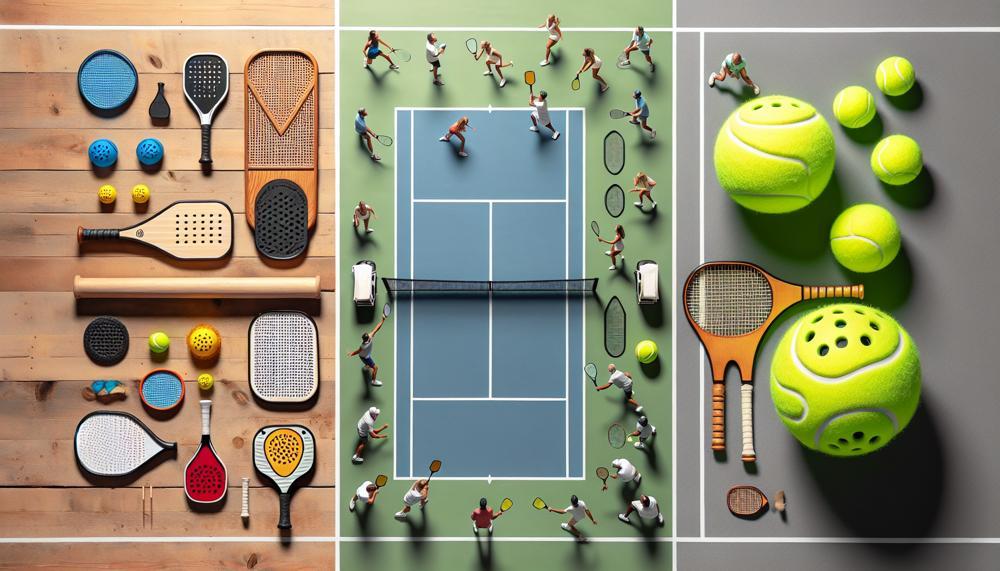
Additionally, pickleball is often played in doubles, fostering a social and inclusive environment where players of all levels can have fun together.
Another factor contributing to pickleball’s appeal is the lower physical demand compared to tennis. The smaller court size and slower pace make it a more attractive option for older adults or those recovering from injuries. And with the option to play indoors or outdoors, pickleball offers year-round enjoyment for players.
Pickleball vs. Tennis: What’s the difference in equipment?
Pickleball and tennis are both popular racket sports, but their equipment sets them apart. Let’s dive into the differences between the two and explore how they affect gameplay.
Rackets vs. Paddles
The most noticeable difference between pickleball and tennis is the size and weight of their rackets and paddles. Tennis rackets are larger and heavier compared to pickleball paddles.
This is due to the size and weight of the balls used in each sport. Tennis balls require more force to hit, so players need a larger and heavier racket to generate power.
On the other hand, pickleball balls are smaller and lighter, allowing for a smaller and lighter paddle.
Materials Used
Another key difference is the materials used to make the rackets and paddles. Tennis rackets are made of graphite and other durable materials like aluminum, titanium, or Kevlar. These materials provide strength and durability, allowing for powerful shots.
In contrast, pickleball paddles are made of lighter materials such as wood or composite materials like fiberglass or graphite. These materials provide better maneuverability and control for precision shots.
Balls Used
In addition to the rackets and pads, the balls used in pickleball and tennis also differ significantly. Pickleball uses plastic balls with holes, similar to a wiffle ball, designed for a lower bounce.
This slower pace allows for longer rallies, making it a strategic game. In contrast, tennis uses rubber balls with a higher bounce, making it a faster-paced and physically demanding game.
Pickleball vs Tennis: Court Dimensions and Layout
Pickleball and tennis are often perceived to be similar sports, but upon closer examination, they reveal distinct differences that set them apart. One of the most conspicuous disparities lies in their court dimensions and layout.
Here, we will delve into the main contrasts between pickleball and tennis courts, exploring the perplexing intricacies of these two sports.
Size Matters:
The foremost and most overt dissimilarity between the two sports is the size of their courts. A pickleball court measures a diminutive 20 feet by 44 feet, while a tennis court boasts a more expansive 36 feet by 78 feet.
This disparity in size not only affects the physical space of the game but also dictates the pace and movement of the sport, making pickleball an accelerated and dynamic activity.
Rackets vs. Paddles:
Another notable discrepancy is observed in the size and shape of the equipment used in each sport. Pickleball paddles are comparatively smaller with a more modest sweet spot, requiring players to exhibit greater precision and control.
Conversely, tennis rackets are larger and have a more generous sweet spot, enabling players to generate more power behind their shots.
Balls:
The type of ball utilized in each sport is another distinguishable factor. Pickleball balls are petite with a hollow core, while tennis balls are comparatively larger with a solid core.
The hollowness of pickleball balls results in less bounce, making it easier for players to manipulate and return shots.
Scoring System:
The scoring system in pickleball is markedly simpler compared to tennis. In tennis, players must acquire four points to win a game, while in pickleball, only two points are required for victory.
This uncomplicated scoring system contributes to the fast-paced nature of pickleball, adding an element of burstiness to the game.
Atmosphere:
Pickleball has a more convivial atmosphere than tennis. It is predominantly played in doubles, emphasizing teamwork and social interaction between players.
In contrast, tennis can be played in both singles and doubles, but it is typically regarded as an individual sport.
Markings and Non-Volley Zone:
Distinct markings set pickleball courts apart from tennis courts, with a smaller non-volley zone in front of the net. This designated area is demarcated by a line, and players are prohibited from hitting the ball while standing within this zone.
This adds a layer of complexity and strategy to pickleball, as players must be mindful of their positioning on the court.
Scoring System: How weird can tennis make it?
The game of pickleball may seem perplexing and bewildering to those who are unfamiliar with it, but its scoring system is what makes it so fascinating and strategic. As someone well-versed in racket sports, I am here to deconstruct the scoring system and showcase its eccentricity and appeal.
Only the serving team has the chance to score points, unlike in tennis, where both players can earn points. This dynamic rule requires teams to work together to maintain their serve and prevent their opponents from scoring. It adds an element of pressure and strategy, making each point crucial in this fast-paced game.
Matches are played until one team reaches 11 points, but here’s the twist – the winning team must have a 2-point lead. Even if a team reaches 11 points first, the game is not over until they have a 2-point advantage over their opponents. This element of uncertainty keeps the game on edge, as teams must continue to fight for every point until the very end.
The scoring system in pickleball also includes side outs and the “win by two” rule. If the serving team fails to score or commits a fault, a sideout occurs, resulting in a change of serve.
This keeps the game moving briskly and ensures that both teams have equal opportunities to score. Additionally, the “win by two” rule means that matches can go on for longer, creating nail-biting moments as teams battle it out for victory.
While the scoring system in pickleball may appear convoluted at first, it is actually quite simple once you get the hang of it.
This makes it an ideal sport for beginners, as they can quickly understand and start playing without having to learn complicated rules. Its accessibility has contributed to its widespread appeal and rapid growth in popularity.
In conclusion, the scoring system in pickleball adds a unique and exhilarating aspect to traditional tennis. Players of all ages and skill levels enjoy it because of the way it combines teamwork, pressure, and strategy to create a fast-paced and thrilling game.
Pickleball Rules vs. Tennis Rules
Pickleball vs. Tennis: A Battle of Dimensions and Rules
As a connoisseur of racket sports, I have observed the rise of pickleball in popularity amongst players of all ages and skill levels. But for those accustomed to tennis, one may find the rules and gameplay of pickleball perplexing.
So, what truly distinguishes these two sports? Let us delve into the main distinctions between pickleball and tennis rules.
Court Dimensions and Net Height
The most evident contrast between pickleball and tennis lies in the court size. Pickleball courts are smaller, measuring 20 feet in width and 44 feet in length, while a traditional tennis court spans 78 feet long and 27 feet wide.
Furthermore, the net’s height in pickleball stands at a mere 34 inches at its center, unlike the 36-inch net in tennis. This compressed court size makes pickleball more accessible and demands less physical endurance compared to its counterpart.
Scoring System
At first glance, pickleball’s scoring system may seem bewildering, but it closely resembles that of ping pong or badminton. The game is played until one team reaches 11 points, with only the serving team capable of scoring a point. In contrast, tennis employs a more intricate scoring system based on games and sets.
Non-Volley Zone
One distinctive aspect of pickleball is its non-volley zone, also known as the “kitchen.” This seven-foot zone on either side of the net prohibits players from hitting volleys (striking the ball out of the air without letting it bounce). This rule promotes strategic gameplay and prevents players from dominating with aggressive volleys.
Double Bounce Rule
Another notable disparity between pickleball and tennis lies in the double bounce rule in pickleball. In this sport, each side must hit the ball before players can initiate volleys. This rule adds an extra layer of strategy, rewarding patience and precision over power.
Gameplay
While both sports involve a racket and ball, the gameplay and tactics in pickleball and tennis differ significantly. Tennis is primarily played as a singles game, while pickleball is mostly confined to doubles play. This difference not only impacts the game’s dynamics but also adds a social aspect to playing with a partner.
Equipment
Pickleball paddles and tennis racquets also have noticeable differences. Pickleball paddles are smaller, lighter, and made of alternative materials compared to tennis racquets.
Health Benefits of Pickleball and Tennis
As ardent players of racket sports, we are constantly bombarded with discussions of the health advantages of engaging in pickleball and tennis. But what exactly are these benefits?
And how do they compare to one another? Let us delve into the realm of these two sports and uncover their distinctive merits for our overall well-being.
Pickleball, a game that has surged in popularity in recent years, is a fast-paced and easy-to-learn sport that amalgamates elements of tennis, badminton, and ping pong, rendering it a dynamic and versatile game.
Its smaller court, slower pace, and lighter paddle make it gentler on joints compared to tennis. This makes pickleball an ideal choice for individuals of all ages and skill levels.
On the flip side, tennis demands greater physical strength and endurance due to its larger court, faster pace, and heavier equipment. Nevertheless, both sports offer considerable health benefits that can enhance our overall quality of life.
Let us closely examine the health benefits of playing pickleball and tennis:
Cardiovascular Health:
Both pickleball and tennis provide an exceptional cardiovascular workout. The perpetual movement and rapid bursts of energy required in these sports elevate heart rate and blood circulation, augmenting heart health.
Regular participation can also mitigate the risk of heart disease, stroke, and high blood pressure.
Respiratory Health:
Engaging in pickleball or tennis on a regular basis can also ameliorate lung health by boosting lung capacity and strengthening respiratory muscles.
This can be particularly advantageous for individuals with respiratory conditions like asthma.
Weight Management:
Pickleball and tennis are both commendable forms of exercise for weight management. A mere 30 minutes of play can burn an estimated 200–300 calories, aiding in maintaining a healthy weight.
Muscle and Bone Strength:
The movements involved in both sports necessitate the use of various muscle groups, rendering them excellent full-body workouts. This can enhance muscle strength and endurance, while also promoting bone health and preventing conditions like osteoporosis.
Balance and Coordination:
The rapid maneuvers and changes in direction required in pickleball and tennis foster balance and coordination. This can be particularly advantageous for older adults in averting falls and injuries.
Brain Health:
Exercise has been proven to have positive effects on brain health, including improved cognitive function and mitigating the risk of cognitive decline.
Popularity: Why is pickleball one of the fastest-growing sports?
Pickleball has become a phenomenon in the world of racket sports, rapidly gaining popularity and attracting players of all ages and skill levels. What sets this sport apart from others?
Let’s explore the factors contributing to its widespread appeal.
- Accessibility: One of the main reasons for pickleball’s success is its versatility. Unlike other sports, it can be played on various surfaces and court sizes, making it accessible to people of all ages and abilities. Whether you prefer indoor or outdoor play, a smaller court or a standard tennis court, pickleball accommodates your preferences.
- Universal appeal: The game’s rules are straightforward, and the equipment is easy to use, making it suitable for beginners while still intriguing experienced players. This allows anyone, regardless of age or skill level, to pick up the sport quickly and enjoy it without feeling overwhelmed.
- Building community: A significant aspect of pickleball is its social aspect. It brings people from different backgrounds together to connect, build relationships, and have fun through friendly competition. It’s an excellent way to meet new people, make friends, and stay active.
- Rising popularity among seniors: The ease of play and social aspect make pickleball a desirable sport for older adults. As we age, staying physically active becomes crucial, and pickleball offers a low-impact option that can be enjoyed without putting too much strain on the body.
- Inclusion in the Senior Olympics: The recognition of pickleball as an official Senior Olympics sport has further contributed to its popularity among seniors. It has given older adults the chance to compete at a high level and showcase their skills.
- Equipment sales: With more people taking up the sport, there has been a surge in paddle and ball sales. This indicates that pickleball is not only popular among players but also has a strong market for equipment manufacturers.
- Tournaments and leagues: As the sport gains popularity, the number of pickleball tournaments and leagues around the world has also increased significantly. This allows players to showcase their skills at a competitive level, adding a new level of excitement to the game.
- Inclusion in traditional sports events: Pickleball has gained recognition as a legitimate sport, even being featured on ESPN2 as part of its X Games coverage since 2001. This has brought more exposure to the sport, introducing it to a broader audience.
Pickleball vs. Tennis: How can I transition from playing tennis to pickleball?
Are you a tennis player seeking a new and exciting racket sport to try? You’re not alone. Pickleball has been gaining traction in recent years, with many tennis players making the switch to this fast-paced and enjoyable sport.
However, before you hit the courts with your paddle, it’s crucial to understand the key differences between pickleball and tennis.
Distinct Equipment Choices
The most apparent difference when transitioning from tennis to pickleball is the equipment used. Pickleball utilizes a smaller court, lighter balls, and shorter paddles compared to tennis.
This makes the game more accessible and enjoyable for players of all ages and skill levels. Additionally, the net in pickleball is lower than in tennis, adding a unique element of challenge to the game.
Simple Scoring System
Another significant difference between the two sports is the scoring system. While tennis uses sets, games in pickleball are typically played up to 11 points, with players alternating serves every two points.
This leads to shorter but more intense matches, making it ideal for players with limited time or those seeking a quick workout.
Court Size and Footwork
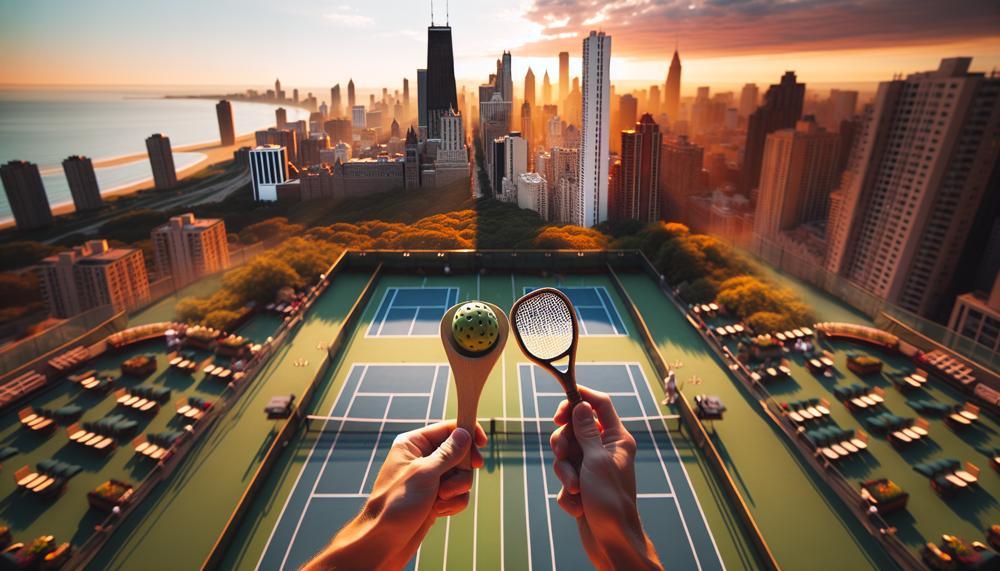
The court size in pickleball is also smaller than a standard tennis court, resulting in variations in play styles and strategies. While both sports require agility and precise footwork, pickleball’s smaller court may require less intense footwork compared to tennis.
Serving Techniques
Serving technique is another notable contrast between the two sports. In pickleball, players use an underhand serve for greater control and precision.
This may take some getting used to for tennis players accustomed to an overhand serve.
Beginner-Friendly Nature
Pickleball is often considered more beginner-friendly than tennis. Its slower ball speed and simpler learning curve make it easier for new players to pick up the sport and enjoy it without feeling overwhelmed. This is particularly appealing for older players or those recovering from injuries.
Professional Tournament Opportunities
Both pickleball and tennis have professional tournaments, but pickleball’s circuit is still developing. However, the sport is gaining recognition and popularity, with more opportunities for competitive play arising each year.
While pickleball and tennis may share similarities, they also have distinct differences that players should be aware of when making the transition. From equipment to scoring to court size, these factors can significantly impact gameplay and strategies.
Pickleball vs. Tennis: Which sport should I play?
When it comes to racket sports, there are two popular options that often leave players wondering which one to choose: pickleball or tennis. Both offer a great workout and opportunities to improve hand-eye coordination, but which one should you play?
Let’s delve deeper into the key differences between these two sports to help you make the right decision.
Court Size:
The first noticeable difference between pickleball and tennis is the size of the court. While tennis courts measure 78 feet long and 36 feet wide for singles matches, pickleball courts are significantly smaller at only 44 feet long and 20 feet wide.
This makes pickleball a perfect choice for those with limited space or who prefer a more compact playing area.
Net Height:
Another distinguishing factor is the height of the net. In pickleball, the net stands at just 34 inches in the center, whereas in tennis, it is 36 inches. This may not seem like a significant difference, but it can greatly impact gameplay.
The lower net in pickleball allows for more aggressive shots and shorter rallies, making it a faster-paced game compared to tennis.
Balls:
The type of ball used in each sport also sets them apart. Pickleball uses a plastic ball with holes, similar to a wiffle ball, while tennis uses a rubber ball with a felt covering.
The pickleball is lighter and slower, making it easier to control and less strenuous on the arm compared to the heavier and faster tennis ball.
Paddles vs. Racquets:
The equipment used in each sport also differs significantly. Pickleball paddles are smaller and lighter than traditional tennis racquets. They have a solid surface and are made of materials like wood, graphite, or composite materials. These paddles allow for better control and precision when hitting shots.
Scoring:
The scoring system in pickleball is similar to that in ping pong, where players must win by two points. On the other hand, tennis uses a more complex scoring system, with games, sets, and matches. This can be confusing for beginners, whereas pickleball’s simpler scoring system makes it more accessible for players of all levels.
Serving:
In pickleball, the serve must be underhand and made below the waist, while tennis allows for an overhand serve. The lower serving position in pickleball makes it easier for players with mobility issues to participate in and enjoy the sport.
Conclusion
Many people have pondered the reason why pickleball seems to be more popular than tennis. But the answer may not be as simple as one might think. While both sports involve hitting a ball with a racquet, they have distinct differences that attract different types of players.
One possible reason for the growing popularity of pickleball could be its accessibility. Tennis requires a larger court and more equipment, making it more expensive and potentially intimidating for beginners.
On the other hand, pickleball can be played on smaller courts with less equipment, making it easier for people of all ages and skill levels to pick up and enjoy.
Another factor could be the social aspect of pickleball. With its smaller court size, players are in closer proximity to each other, allowing for more interaction and camaraderie during games. This creates a sense of community among players, which can be lacking in individual sports like tennis.
Additionally, pickleball has been described as a combination of various sports such as tennis, badminton, and ping pong. This fusion of elements makes it unique and appealing to those who may not be interested in traditional sports.
Furthermore, the fast-paced nature of pickleball makes it an exciting sport to watch and play. The shorter court length means rallies are quicker and require more agility and reflexes from players. This intensity can be addicting for those who thrive on adrenaline-fueled activities.

